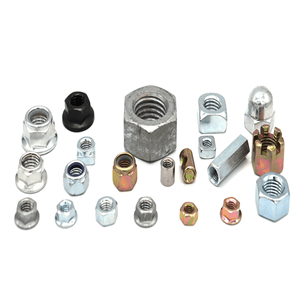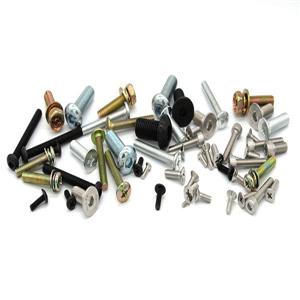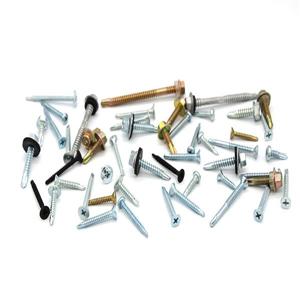Stainless steel fasteners we often encounter is the problem of stainless steel standard parts locking
Stainless steel fasteners The problem we often encounter is the locking of stainless steel standard parts. So why do stainless steel fasteners always lock up? What is the reason! Why haven't you heard that the standard parts of iron do not lock up? This may be seen from the two materials of stainless steel and iron. Stainless steel standard parts are relatively soft and have good ductility. The hardness of stainless steel standard parts is SUS316. Compared with the hardness of iron standard parts, the hardness is softer than that of iron standard parts of 8.8. Fastener users often reflect: Why do stainless steel fasteners sometimes lock up, and similar phenomena do not often occur when using carbon steel fasteners, are stainless steel fasteners softer and carbon steel? Why are fasteners relatively hard? That's right! There is a fundamental difference between stainless steel and carbon steel. Stainless steel has good ductility, but its hardness is somewhat different from carbon steel.
Thread Galling (or tight tightening) often occurs on fasteners made of stainless steel, aluminum alloys and titanium alloys. These types of metal alloys have inherent anti-corrosion properties. When the surface is damaged, A thin oxide layer (in the case of austenitic stainless steel, chromium oxide) is produced on the metal surface to prevent further and deeper corrosion. When the stainless steel fastener is locked, the pressure and heat generated between the tooth patterns will destroy and erase the chromium oxide layer between them, so that the metal tooth patterns will directly block / shear, and then the adhesion phenomenon continues to occur ( It usually does not exceed one complete tooth diameter), which will completely lock the stainless steel fasteners and can no longer be removed or locked. Usually this series of blocking-shearing-adhesive-locking action takes place in just a few seconds. Therefore, understanding the characteristics of stainless steel products and following the correct operating procedures are the first steps to prevent stainless steel fasteners from locking up. step.
External causes of deadlock
⑴If the product is not selected properly, please confirm whether the mechanical properties of the product can meet the requirements of use before use (such as the tensile strength of the screw and the safety load of the nut). In addition, the length of the screw should be selected appropriately. One or two pitches of the nut are exposed after tightening.
粗糙 The teeth are rough or there is foreign matter sticking to them. If solder joints and other metal shavings are interposed between the teeth, they often lead to locking.
(3) Use too much force or the locking speed is too fast. Use a torque wrench or socket wrench as much as possible, and avoid using an adjustable wrench or electric wrench. Because the electric wrench often causes the locking speed to be too fast, the temperature rises rapidly and locks up.
角度 The nut with the wrong angle in the force direction must be screwed perpendicular to the axis of the screw, and it must not be tilted.
⑸The use of washer / retainer can effectively prevent the problem of over-tightening.
Preventive measures and solutions to prevent the locking of stainless steel standard parts
1. When using stainless steel, always lock the nut at a fixed speed?
If you are a first-time user or are unfamiliar with the technology of stainless steel products, you should ask your supplier about the relevant characteristics of stainless steel. Generally speaking, slowing down the locking speed can greatly reduce (or even completely avoid) the chance of locking up. Because thermal energy often occurs at the time of locking, as the thermal energy increases, the probability of locking will also increase. In use, the speed of locking stainless steel fasteners should be lower than the speed of locking carbon steel.
2. Lubricate the screws or nuts before locking?
If the answer is no, it is recommended to use butter, molybdenum disulfide, graphite, mica or talc to lubricate the internal and external tooth lines to reduce the occurrence of lockups. Coating is also an effective method of lubricating. A nut that has undergone the process of stopping will be like a layer of lubrication film between the nut and the screw.
3. Do you choose screws and nuts of the same material grade?
If the answer is yes, you can suggest using different grades of screws and nuts, such as 304 with 316 and so on. However, it should be noted that the selected stainless steel grade must also meet its own requirements for rust and corrosion resistance.
In addition, locking is the most common case when locking the flange. Assume that you have paid attention to and followed the above points, including the use of washers, coating nuts (longer nuts can also be recommended, such as GB6170 or DIN934), nuts in a diagonal order, and slowly turning to the appropriate tight If you still ca n't solve it, you ca n’t remove it after pre-locking. Finally, you have to temporarily use carbon steel nuts when pre-locking the flange device, and then use stainless steel screws when it is finally locked. Cap to find a balance between beautiful rust resistance and non-locking.
Stainless steel standard parts are prone to lock-up phenomenon, and lock-up phenomenon has occurred, then we must first find out the cause of the output lock-up phenomenon. Then analyze and deal with the cause of the lockup in a targeted manner, choose a good solution, and solve the lockup problem of stainless steel standard parts at a reasonable and correct speed.




